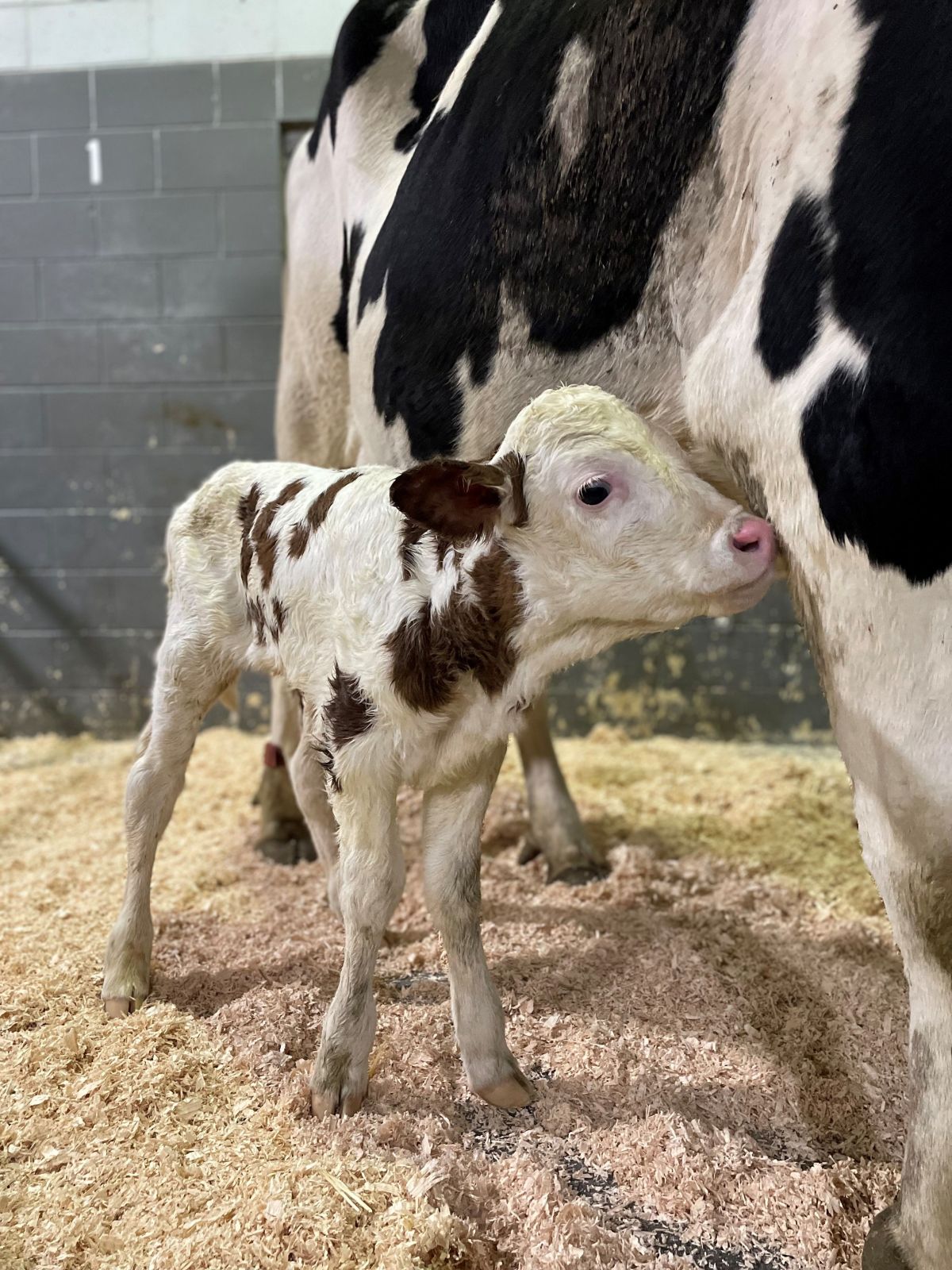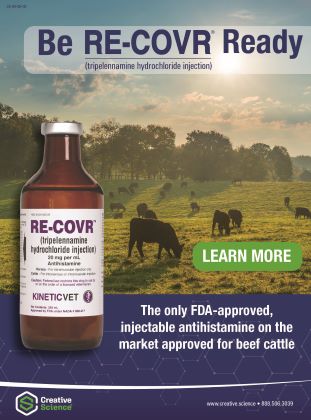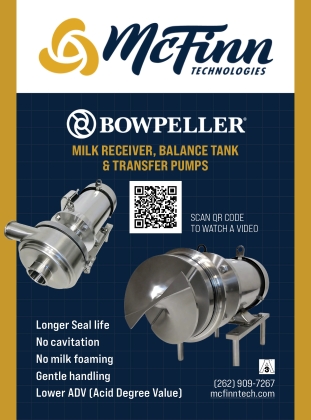Newborn Calf Care

Newborn Calf Care
Dairy calves are more fragile than beef calves and have more health risks early in life. It is imperative to make sure they get off to a good start and this includes intensive management immediately after birth.
Dr. Pete Erickson, Professor of Dairy Management and Extension Dairy Specialist, University of New Hampshire, says it is crucial to dip navels in iodine and get colostrum into those calves as soon as possible. “New data from various studies has indicated that newborns need at least a gallon of colostrum, even up to six or eight quarts within the first 8 to 12 hours of life, and at least a gallon right away,” he says.
“We make sure the calf has an adequate amount of high-quality colostrum as soon as possible because all neonatal pre-ruminant animals have a naïve immune system. The only source of passive (temporary) immunity is colostrum,” says Erickson.
The calf must receive antibodies from the dam’s colostrum. In late gestation the cow starts making colostrum and transfers antibodies she has produced against disease into that colostrum. This is why it pays to vaccinate cows ahead of calving, so her own immunity is strong and she can pass on to her calf (via colostrum) the antibodies she’s created.
Most dairies save the first milking from freshening cows, to freeze for later use, for newborn calves. Before saving it for this purpose, however, it is important to make sure it is good quality. Some cows producer better colostrum than others.
“So how do you tell if it’s good quality? The easiest way is to invest in a Brix refractometer. There are some digital refractometers that make this really easy. You just put a drop of colostrum on it and it gives a reading of a certain value. It’s a good idea to do it a couple times a couple different drops. You want to be sure the colostrum has a minimum of what we call a Brix of 22.5%, similar to 50 grams per liter of IgG.”
The old-fashioned way, which is probably a little more reliable but a little harder to do is to use a colostrometer. “The challenge with this is that the colostrum must be room temperature,” says Erickson. This kind of test may take longer because you might be checking colostrum that was frozen, or colostrum right from the cow, which would be about 102 to 102.5 degrees. You’d have to wait for it to get to room temperature but with the Brix you don’t have to wait.
“One thing we’ve been doing research on and other people have been researching, is that sometimes cows don’t produce much colostrum, especially Jersey cows. It’s been thought that this is more of a problem in winter, but we’ve done a lot of research on that in my laboratory and some other laboratories and we’re not really sure about the cause. Some people think it’s because its winter, or shorter daylight hours, but I don’t necessarily believe that. I think it is more related to environmental temperature. Manipulating daylight length with lighting doesn’t seem to have an effect,” he says.
“We are doing a study here right now to evaluate this problem, utilizing Holsteins and Jerseys from our two herds here and a commercial herd, looking at the effect of temperature. We have some extreme temperature swings here, where it can be very hot in summer and very cold in winter, so are looking at this to see if we can develop some type of model that will indicate whether the hormone prolactin is involved in the lack of colostrum. It might be the key to this problem.”
Meanwhile, what can people do when a cow doesn’t have much colostrum? “You need to have some frozen colostrum and/or some colostrum replacer products on hand. Those need to be really good quality so you want to make sure that whatever you buy is colostrum based. Don’t use blood-based products. They may be ok to use a little later for a calf, but not for the first and second dose,” says Erickson.
Some dairies have a colostrum bank. It is a good idea to harvest colostrum from fresh cows during the year, test it for quality and save the best colostrum to freeze. “There are now some bags especially developed for this purpose and you can buy them online. There are some four-liter bags and two-liter bags. Some are set up to where you can put a nipple on the bottom of the bag after you’ve thawed it.”
Another way people freeze colostrum is in two-liter soda bottles since they can also have a nipple attached after thawing. There are also many kinds of bags that can lie flat in the freezer for ease of storage and thawing, with more exposed surface for thawing. “You never want to thaw it fast. If you put it in really hot water the heat starts denaturing the proteins.” The antibodies will be destroyed.
If you know a cow will be calving in a few hours you can start thawing a bag of frozen colostrum in warm water and then make sure it is proper body temperature for the newborn calf so it can be administered very soon after birth.
Colostrum provides not only antibodies against disease, but also has a laxative effect to help the calf pass its first bowel movements. It also contains a rich and easily digested fat that can be utilized as instant energy to help a calf keep warm, as well as fluid to keep the calf hydrated.
“A baby calf is born with only about 3% body fat and needs the fat from colostrum to help develop body heat and insulation. If the calf doesn’t drink much on the second feeding we usually don’t worry about that because it probably has a full belly but that first feeding is crucial. Calves are also often given vaccinations the first day, and this may be an oral vaccine,” he says. It’s important to work with your herd health veterinarian to make a vaccination plan for your calves.
Importance of Water and Starter
“We try to feed some regular milk by the second day. “The young calf needs a source of hydration. I am all for starting each calf on water immediately, as well as calf starter. Some people say calves won’t drink water at first and think they don’t need water until they are a little older, but water is important from the beginning. This summer was so hot and humid here that we saw a calf drinking water on day two of life. This calf figured it out and was drinking water the second day. Some people say they don’t start drinking water until they are about two weeks old, but why risk a problem?” Water should be provided and always available.
Beef calves start drinking water very early, mimicking mom, and also start eating whatever she’s eating. Diary calves need the same opportunity to eat and drink. “Provide some free-choice starter. I like to feed coarse starter; I am not a fan of pelleted starter but some big dairies have to use the pelleted starter. In that case you should chop up some really good-quality hay to feed with the pellets, or feed it separately. The important thing is an environment that is conducive for the calf to eat; they will start eating very quickly if conditions are right, if they are comfortable and not cold or wet,” says Erickson.
“The next day after colostrum you probably should start feeding some milk or milk replacer. There are many ways to feed calves,w ith automatic feeders, or bottles or pails. Here in our part of the country we are seeing more automatic feeders and there are big debates on how much to feed. Right now we are feeding 6 liters of milk replacer a day and some free-choice starter and our calves are doing well, though some people say that’s not enough milk replacer,” he says.
“You want a calf to double its initial body weight by weaning at about 8 weeks of age. Some people feed calves anywhere from 6 liters to 12 liters per day but I tend to lean toward the conservative side (6 liters) along with free-choice starter and free-choice water. We always need to make sure they have free-choice water. There is not enough fluid in milk replacer by itself. It contains a lot of protein and minerals and you can really mess up the osmotic balance in the calf’s body, especially if you feed a lot of high-protein milk replacer. If the calves don’t have free-choice water they can actually die of dehydration,” he says.
“We did a study a few years ago in which we fed a conventional milk replacer versus a high-protein milk replacer. We saw that the calves that were fed the accelerated high-protein milk replacer drank twice as much water as the calves on the conventional four quarts of milk replacer per day. The idea that they are getting enough water via all that milk replacer is not true. They need water to balance out the high protein and mineral level in that replacer,” says Erickson.
“Always provide free-choice water and free-choice starter and choose how you are going to do it. A person can successfully raise calves by feeding quite a bit of milk or a limited amount. There is conflicting data; some indicates that if you feed them more milk they will produce more milk when they become cows and some people say that if they consume more total dry matter when they are babies they will be more productive cows,” he says.
“The bottom line regarding care of newborns is calving in a clean place, providing a clean dry place for calves, clean bedding, at least a gallon of good-quality colostrum at birth (actual amount depends on if it’s a big Holstein calf or a small Jersey), and dip the navel. If weather is hot you might dip the navel a couple times in the first 24 hours.”
The important thing is to make sure the navel stump is drying up, and it may take several applications of iodine. “If it’s hot and humid you need to make sure it is actually drying up,” he says. The heifer calves’ navels dry up faster; the little bulls often urinate lying down and the navel stays moist longer.
Calf Care on a Missouri Dairy
Scott E. Poock, DVM, DABVP (Dairy), Extension Professor, University of Missouri, says a person should always be cautious around a cow that has just given birth, but a dairy cow is less apt to be aggressive than a beef cow. “There is so much data that shows calves have less chance to get sick and a much greater chance to survive if we take them away, because of Johne’s disease and other diseases, as well as increased passive transfer.” If the calf can be taken immediately and put in a clean place, with no fecal material from the cow, there is less chance for several types of infection.
A study in Ireland showed this very clearly, that the longer the calf stays with the cow, the greater the chance that the calf will pick up Johne’s. There are several drawbacks to leaving the calf with mama very long; if it’s a vigorous calf, suckling and bunting at the distended udder, the cow’s udder could be bruised and more at risk for mastitis. Beef cross calves are usually very vigorous, up and nursing within a short time.
“A Holstein calf, by contrast, if it stayed with the cow and was up and nursing within an hour I would be amazed. The crossbred Jersey-Holsteins are a little more vigorous and aggressive, but the beef-on-dairy calves will be up and nursing practically before you know it. Being half beef really increases the vigor,” says Poock.
“If we take them away, however, they can do better because we can give them a known quantity of a known quality colostrum at a known time. Timely consumption of an adequate amount of good-quality colostrum greatly benefits and affects their health and production as cows, through several lactations.” They get off to a much better start.
“We want to get colostrum into them within the first hour. We used to think that if we gave it within the first 12 to 24 hours the calves could get a portion of the necessary IgG, but now we know the gut closure starts quickly. As soon as they get something in their mouth and swallow, it begins to close.” It’s a race between the antibodies and the pathogens, to be absorbed.
The bigger farms that have a large pool of colostrum often get it into their calves within half an hour. “Some smaller farms like our university dairy collect colostrum, test it for quality, using the Brix scale, and freeze it for later use if it is greater than 22% Brix. Since our colostrum is frozen, as soon as we know we have a new calf, we use a piece of equipment called Matilda that will thaw it. This takes about 45 minutes to warm up and then stay at 105 degrees until we feed it,” he says. This is a real time-saver and does a good job of warming it without denaturing the proteins (antibodies). This makes it possible to administer it to a calf within an hour of birth, at proper temperature.
“The rule of thumb is to give a calf 10% of its body weight as colostrum. Most Holstein calves will get a gallon. You could let the calf suckle a bottle and drink that much, and a beef-on-dairy calf will probably do it, but most people just tube a Holstein. There are many studies that show it doesn’t matter whether you let them suckle it or give it by tube; they get the same effect,” Poock says.
“We occasionally check cleanliness of colostrum. If it contains a lot of bacteria this will decrease absorption. What we do here, and I recommend this for most dairies, is to check total proteins on calves that are one to seven days old. We take a blood sample and look at the total proteins (to see if the calf received adequate antibodies from colostrum). The new parameters state that more than 40% of the calves should have total protein of more than 6.2 grams per deciliter or higher. You don’t want calves below 5.2. I’ve worked with some herds that had 80% or more of the calves above that 6.2,” he says.
“Most of those herds feed a gallon soon after birth and come back and feed another two quarts at 8 to 12 hours, for a total of 6 quarts. Most farms here in Missouri run about 50% if they have really good colostrum and good colostrum management. If you can do that, your calves will be healthier and make better cows.”
The dairies he has records on tend to have fewer than 5% stillbirths (dead on arrival, which can happen with a difficult birth), and the really good herds have less than 3%. “Calving ease within the Holstein breed has vastly improved. We were quite a ways behind beef breeds in achieving this.” This breed has such a huge database that this was accomplished quickly.
“Just looking at our university dairy from when I came here in 2006 to now, we don’t pull as many calves. This is much easier on the cow, and the calf. We can use sexed semen, to get heifer calves from heifers, which means a smaller calf, and only use semen from bulls that are considered calving ease, as well. This gives the heifer a chance to calve easily and recover quickly,” says Poock.
“When I was in private practice I began to see this change. A bull named Oman was exceptional for calving ease. I worked with a herd that had nearly 60 daughters by him, because they used him so heavily on heifers. Those heifers would just lie down and calve quickly.” This makes life easier for everyone!
It is also important to dip the calf’s navel in iodine as soon as the umbilical cord breaks. “For this, we recently switched from a multi-use cup (re-used on multiple calves) to a single-use Dixie cup and this has really helped keep everything cleaner. You just put the proper amount in the cup for a good dip and thorough soak, and the stump starts drying up quickly,” he says.
“If you run into trouble, then you might do it a second time, and make sure the stump is drying up. It’s important to use strong iodine because it works the best as an astringent as well as disinfectant. One farm was having problems until they realized they were just using alcohol; they ended up with some navel infections. After they changed to iodine, and started using a one-time-use Dixie cup to be cleaner, they had no more problems.”
Vaccines
Vaccinations are also important. Some people use intranasal vaccine on day one. “This is now fairly common, and on some farms you may have to booster that, but in general we can get away with one dose. I don’t mind giving intranasal vaccines because that can circumvent interference from maternal antibodies. You are stimulating the IgA rather than the IgG. There is not much IgA in colostrum; it is mostly IgG,” says Poock.
“I don’t recommend doing much vaccinating (other than intranasal) until calves are at least 30 days of age. By that time their immune system has picked up enough and the immune cells in their body can respond. Before that, the immune system is immature. There are not many immune cells yet in circulation and they just don’t respond as well, especially if the calf received a good amount of high-quality colostrum and still has some passive immunity.” The body sees no reason to respond.
“There is usually not much response at this age to killed vaccines. You might get away with using modified live because it stimulates both the humoral and the cellular immunity but in general I don’t want to vaccinate any calves with anything other than intranasal until after they are 30 days of age,” says Poock.
“What we do here is give a first dose of modified-live vaccine (IBR, BVD, PI3, BRSV with lepto and a 7-way clostridium containing blackleg) at day 40 to 45 and about 2.5 to 3 weeks later we booster those, and after that we wean those calves.”
December 2025
By Heather Smith Thomas
More Cattle Industry News found here
If you enjoy the Outdoors stop by the Iowa Sportsman



